#retro api
Explore tagged Tumblr posts
Text
WinAmp 5 – rusty color and what is required

So, at my summertime retro computer Asus F3S., I have installed program for audio – WinAmp version 5.666 from 2013. So, this computer is going with Windows Xp. So, it is perfect for this. Good program. As I remember I used WinAmp 2 something. In age of my Pentium 2. It was a long time ago. So, I do not remember, already.

So, I with a great pleasure install some more new WinAmp. It looks beautiful, and lots of functions. And it reminds me some CD Player. I am talking about a big squares from 80s-90s.As a part of music center. So, a soft style Winamp 5 is looks like part of a music center. So, it is such a music player with lots of buttons.

Nothing tricky. There is playlist, library. And windows with what is playing now. And mainly it has lots of settings. And there is change in visual theme. I select rust. So yellow brown color. Part of indications you can hide. And opposite - to show more info. So, player can look compact, as at full screen.
So, it is such a nice music memory.

Dima Link is making retro videogames, apps, a little of music, write stories, and some retro more.
WEBSITE: http://www.dimalink.tv-games.ru/home_eng.html ITCHIO: https://dimalink.itch.io/ GAMEJOLT: https://gamejolt.com/@DimaLink/games
BLOGGER: https://dimalinkeng.blogspot.com/ DISCORD: https://discord.com/invite/F24Kw7TaH4 TUMBLR: https://dimalink.tumblr.com/
#retro#windows xp#winamp#winamp 5#xp soft#retro soft#player#music player#cd player#mp3 player#retro api#playlist#library#music library
6 notes
·
View notes
Text
Create Retro ASCII Text Art with BitmapIt JavaScript
BitmapIt is a lightweight JavaScript library that transforms plain text into customizable bitmap-style ASCII art representations. It’s ideal for creating retro terminal aesthetics, game interfaces, and nostalgic text displays in web applications. Features: Customizable display characters (e.g., blocks, symbols) Adjustable character width, height, and inter-character spacing Simple, clean API for…
2 notes
·
View notes
Note
You seem to like retro PCs, so do you have any thoughts on the IBM 5100, star of Steins;Gate?
That one's outside my field, but I looked it up and saw stuff about it coming with options for two different programming languages.
That reminded me of a time I was talking with an older dude I rode the bus with about computer stuff, and he used to program business mainframes. He asked something like "Is Python just for Linux, what operating system is it for?" and I got to attempt to explain that for the most part, programming languages aren't tied to specific systems anymore.
Of course you have assembly but nobody uses that, and you have libraries and APIs and so on that're tied to a given operating system but full on programming languages have compilers on anything these days. It's so beautiful how you can change to a totally different machine and still code in whatever language you were using before.
8 notes
·
View notes
Text

What if... Bendy and the Ink Machine, but with me and my characters instead? :)
I've made a custom Sketchtober list, and retro cartoon Api and Lotl was actually the prompt for the 24th and 25th. But I felt inspired, and why would I ignore that flash of motivation. Of course my brain cooked up a little storyline too, ugh.
My heart does the happy emoji when I let myself embrace the cringe.
Lotl really is a perfect Bendy replacement, small and spiteful. They even got their drool goop that looks like ink. And I've mentioned this long ago in an old post, but this voice fit Lotl so well.
6 notes
·
View notes
Text
Writeup: AOpen i945GMm-HL shenanigans
AOpen i945GMm-HL - The Retro Web
Welp. This board is weirder than I ever thought it'd be. Not the board in general, but the specific one I bought.
To begin, it turns out that my particular board, and likely many others of the same model, are OEM-customized boards that AOpen provided to a little company called RM Education. They make all-in-one PCs for the UK market.
...And they are using evaluation BIOSes (in other words, BIOS software that's normally only meant for prototyping and... well, evaluation) in their retail boards.
My specific board contains BIOS version R1.08, which is actually R1.02 apparently. There is evidence of an R1.07 existing as well from a reddit thread on the r/buildapc subreddit, but I doubt that it's been dumped anywhere.
Moving on to the original point of this writeup, I got this board because I wanted to build a system that pushed the 32-bit Core Duo T2700 as far as possible, meaning I needed a mobile-on-desktop board. AOpen built a reputation for doing this sorta stuff in the 2000s, so I went ahead and picked one of their boards for use (although I would've much preferred using the top of the line AOpen i975Xa-YDG instead if it were being sold anywhere. That's a VERY tasty looking board with its full size DIMM slots and SLI-compatible dual PCIe x16 slots and ability to crank the FSB all the way to 305MHz).
Slightly surprisingly, the Core Duo T2700 is quite the overclocker! It's able to push from 2.3GHz all the way up to 2.7GHz with some FSB overclocking using the SetFSB tool. It's multiplier-locked to a range from 6.0 to 14.0, so I can only push it through this means.
The board I'm using, the AOpen i945GMm-HL, supports running the FSB up to 195MHz. It's okay-ish in terms of stability, but crashes when running Aida64 benchmarks unless I loosen the memory timings from the 5-5-5-15 settings that it uses at 333MHz to 5-6-6-18, which is just the tiniest bit faster than its stock settings for 400MHz operation by SPD. With these settings, it's much more stable and is able to run the benchmarks, though unless I lower the FSB from 195MHz to 190, it will consistently crash Chrome when trying to play Youtube videos on integrated graphics. I'll likely experiment some to see if adding a card capable of handling the video playback in hardware helps.
For now, this is all for this blog post. I'll follow-up with more details as they come in reblogs. As follows are the specs of the system:
AOpen i945GMm-HL (OC'ed from 166MHz FSB to 195MHz, 190MHz for more stability)
Intel Core Duo T2700 @ 2.7GHz (OC'ed from 2.3GHz)
2x 2GB Crucial DDR2 SO-DIMMs @ 5-6-6-18 timings
Some random 40GB Hitachi hdd lol
Windows XP Pro SP3, fully updated via LegacyUpdate
Supermium Browser (fork of Google Chrome and the reason why I was able to test Youtube playback in the first place)
Coming up: Installing One-Core-API and Java 21 to play Minecraft 1.21 on a 32-bit system out of spite for Microsoft "dropping support" for 32-bit CPUs.
2 notes
·
View notes
Text
Imagine living in the BLADE RUNNER story-world with OCD. Frantically checking if you're a Replicant on a retro-futuristic CRT piece of shit device that charges you a dollar per API call. Only to check all over again an hour later.
6 notes
·
View notes
Text
Emulation
I've been thinking about emulators a lot recently, since getting a retro-handheld and emulating a bunch of games. I'm having a lot of fun with it, and I've been inspired in various ways - I'd love to put together a project that integrates a lot more game improvements into an emulator. Here's some of those concepts:

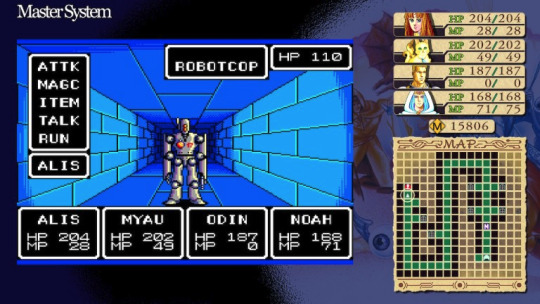
(Pictured above, Phantasy Star 1 for the Nintendo Switch, showing emulated game and extras like maps and character healths)
(1) Extra-Textual Information
I've seen a few emulators dabble in this with varying degrees, and I always find it a treat. Some things, like providing things like maps or quests that the original game didn't track for the player (due to tech limitations) or more narrative-contextual things like character portraits or illustrations from the manuals. Shout out to the WanderBar plugins developed by Legends of Localization author, Clyde Mandelin.

(Pictured above, Seiken Densetsu/Final Fantasy Adventure showing emulated game and extras like enemy stats or item descriptions and illustrations from the manual)
Additions like this are important for many different reasons; more approachability to a wider audience (Truncated text like LIT3 from Final Fantasy 1 spring to mind), a richer more 'fulfilled' version of the game the artists and designers intended but couldn't represent, and accessibility features that allow differently abled people to enjoy games in an era that frankly didn't make much of an effort.
And, integration with existing walkthroughs wouldn't go awry, since older games sometimes require esoteric requirements to progress that are simply unreasonable to ask in the more modern era of game design. (Though opting in to these systems would be a necessity)

(Pictured above, a screenshot of an Ascii rendering of the title of The Legend of Zelda, A Link to the Past, from GameFaqs. Ascii you can trust!)
Honestly, I could go on and on. Things from concept art to advertisements to additional media like the Link to the Past Comic would give a more fulsome and authentic experience.
(2) Modding and User Generated Content
Really, the above are only possible via community efforts, obsessively collecting data. Thus, the ideal system for this to work within is one that in open source and has robust and well-documented modding tools.
Having used Mesen and Project64 to mess with graphics and textures, this is really powerful, but also feels like a half-measure at times, as it's still restrained within the graphics capability of those systems, and often simply a 'resolution' slider.
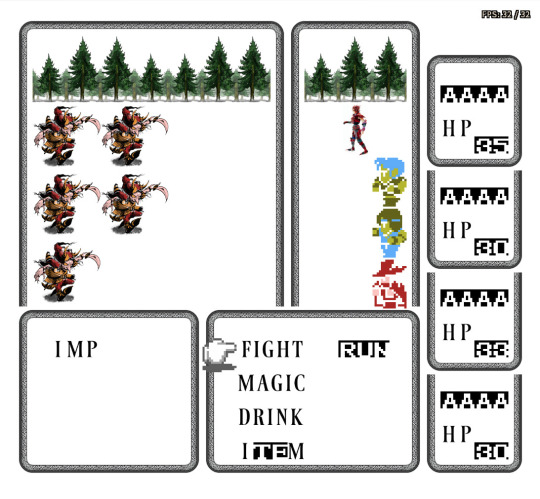
(Pictured above, an unfinished Final Fantasy Mod replacing graphical assets with concept illustrations from Yoshitako Amano)
One thing that springs to mind is the implementation of the Diablo 2 Remaster; The developers spoke about essentially having an "API" to reach the important parts of the game's original implementation to then add extra (visual) information on top of. Things like 'player facing direction' can be added on to in order to rotate the rendered model and slerp it smoothly between those angles, something not possible in the original implementations.
Thus, the core of the game is preserved, with only the presentation changing.
This is mentioned for it's structure, obviously there's tons of labor that goes into these graphical assets that just aren't possible for a layman to create a games' worth.

(Pictured above, a comparison of screenshots of Diablo 2 and Diablo 2 Remastered demonstrating the rendering-level improvements)
(3) Creativity and Freedom
The two above points really imply this third one, which is a more collective ownership by the community. Something that a system like this would unlock is the ability to remix and remaster a game in a way that could be anything - respectful to the original intent, or a wild re-imagining of what the game might look like directed by you.
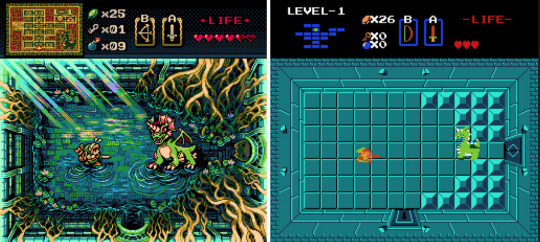
(Pictured above, the Boss Room from Legend of Zelda redrawn with a much higher fidelity pixel art)
(Credit to Zaebucca, apologies for reposting art without reblogging it properly. Link)
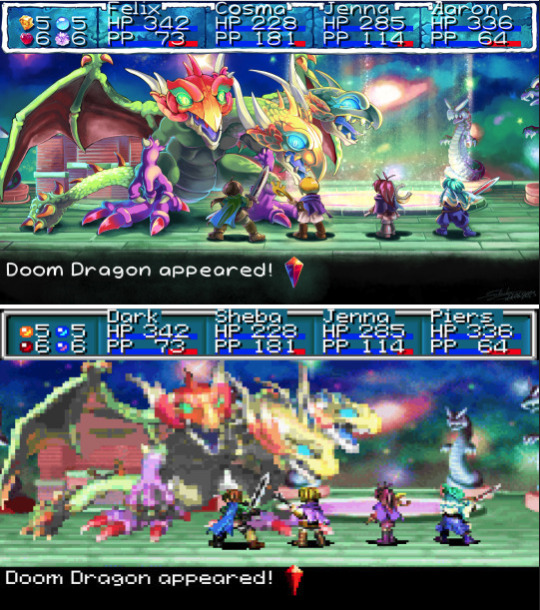
(Pictured above, a Dragon Boss Fight from Golden Sun redrawn as higher quality digital art)
(Credit to Sabbitabbi, apologies for reposting art without reblogging it properly. Link)
This sort of preservation-through-community is wildly important in an era of games that have been all but abandoned by their developers (if the studios in question still exist, even) and games that are profound in shaping the genres of their era are fading away; Something that the youtuber Nerrel has touched on in various videos of his.
(4) Actually Making the Damn Thing
There have been some previous work on things like this that I really admire, but haven't really seen (or weren't built for) widespread popularity in the larger gaming sphere.

(Pictured above, the dragon boss from Legend of Zelda, projected oddly into a 3D scene with a sword being thrown sideways at it)
One well meaning but obviously comedic attempt was done by Tom7 (Suckerpinch) on youtube, where an automatic system was programmed to 'convert' NES games to 3D. It's an interesting experiment but honestly proves to me that any automatic or AI assisted route is futile; that this would have to be hand tuned or developed.
A similar attempt to the above is the steam released 3dSen, which is really impressive but has similar pitfalls to other emulators described above - by systematizing the rendering, it imposes strange and unintuitive requirements on graphics that simply don't have to be constrained that way. This is caused by the automatic nature of the game (see water tiles below)

(Pictured above, 3DSen screenshot showing graphical problems when rendering water tiles)
So what the heck does the ideal system look like for this sort of thing?
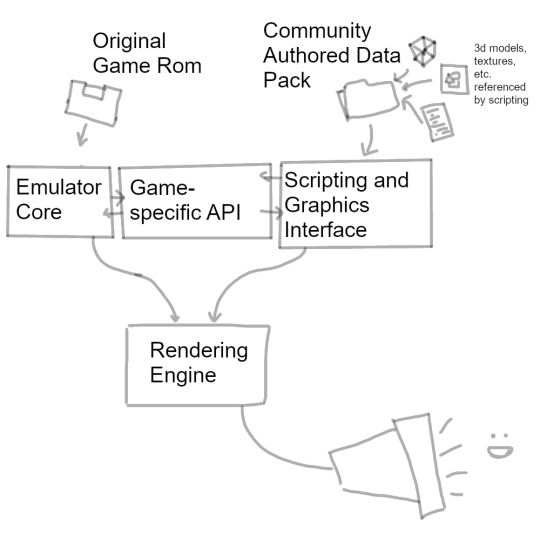
The biggest parts of those (and I'm omitting a bunch of things, obviously) would be an emulator core with game-specific knowledge built in that's available to a scripting layer. The scripting layer in turn would interact with this and where appropriate interrupt the emulator's rendering to inject models, sounds, menus, etc.
The original game rom would not be distributed in any way, but could easily be md5 checked and verified for correct behaviour with the API. The Data Packs would ideally be a solid file (probably just a renamed zip lol) so they could be easily distributed and 'opened' by the emulator, instead of having to do tedious mod installation.
Within the data packs would be some sort of scripting initialization hooks and file organization such that resources are appropriately loaded and fed to the rendering system as needed.
Now, as for when I actually start working on this...? Whew, we'll see. But I'm hoping this resonates with some folks out there!
2 notes
·
View notes
Text
Level Up Your Fun with These Top 15 Gaming Platforms for PC

Source: rocketbrush.com
If you love PC gaming, the right platform can change everything. Gaming platforms for PC are where you get your games, play with friends, grab special deals, and build your dream game library. But with so many options out there, which one should you pick?
In this article, we break down the top Gaming Platforms for PC, what makes each one special, and how they can take your gaming experience to the next level.
1. What Is A Gaming Platform?
A gaming platform for PC is a software service called a launcher or store that handles everything from a digital storefront and game management to social features and updates. These platforms simplify launching games, patching them, organizing your library, cross-platform access, and connecting with friends.
Examples include Steam, Epic Games Store, and Ubisoft Connect.
Top 15 Popular Gaming Platforms for PC:
Below are the most widely used Gaming Platforms for PC,

1. Steam: The leading platform with the largest PC library
Performance & Compatibility – Solid performance, works on Windows, macOS, and Linux via Proton.
Key features:
Massive game catalog
Social/Community tools
Workshop/mod support
Cloud saves
Frequent sales
Visit Website
2. Epic Games Store: Free weekly games, exclusives
Performance & Compatibility – Great speed, light on the system, and Supports Win/Mac
Key features:
Free weekly title
Developer-friendly cuts
Cross-platform syncing
Mod support
Basic social
Visit Website
3. GOG Galaxy: DRM-free library, retro titles
Performance & Compatibility – Fast and light, Supports Win/Mac/Linux
Key features:
DRM-free games
Old title supports
Optional client
Integration with others
Mods friendly
Visit Website
4. Ubisoft Connect: Ubisoft’s launcher with in-game rewards
Performance & Compatibility – Moderate resource use, Optimized for Windows
Key features:
In-game challenges/rewards
Uplay to connect and upgrade
Social stats
Cloud sync
Storefront
Visit Website
5. Battle.net: Blizzard/Activision games management
Performance & Compatibility – Lightweight, Fast on Windows
Key features:
Access Diablo/Overwatch/CoD
Cross-game chat
Auto-update
Easy installs
News hub
Visit Website
6. Origin (EA App): EA exclusive and third-party titles
Performance & Compatibility – Efficient, Supports Windows/Mac
Key features:
EA titles + others
Subscription (EA Play)
Early trials
Social/chat
Cloud saves
Visit Website
7. Microsoft Store/ Xbox App: Microsoft-curated store and Game Pass
Performance & Compatibility – Smooth on Windows, UWP format
Key features:
Game Pass integration
Cross-platform Xbox sync
Cloud storage
Social/chat
Frequent bundles
Visit Website
Similar Article:
The Best Gaming Websites for Gamers of All Levels
Boost Traffic with These Smart Gaming Website Design Tips
8. itch.io: Indie games hub, pay-what-you-want
Performance & Compatibility – Lightweight Windows and web client
Key features:
Indie discovery
Custom pricing
Developer support
Tag/search
Simple installs
Visit Website
9. Amazon Games: Amazon’s PC storefront
Performance & Compatibility – Standard Windows client
Key features:
Prime member benefits
Free titles
Game streaming (Luna)
Auto-update
Cloud saves
Visit Website
10. Bethesda Launcher (merged with Steam): Older Bethesda titles, updates via Steam
Performance & Compatibility – No longer active, legacy Windows support
Key features:
Official updates
Mods support
Community hub
Auto-patch
License management
Visit Website
11. EA Play (via Steam/Epic/Origin): EA’s subscription game hub
Performance & Compatibility – Hosted in the existing launcher, normal performance
Key features:
Unlimited EA games
Early access
Cross-platform cloud saves
Discounts
DLC access
Visit Website
12. Humble Bundle: Bundle deals, DRM-free + Steam keys
Performance & Compatibility – Lightweight API app
Key features:
Charity bundles
DRM-free or Steam keys
Library tool (App)
Cross-platform support
Cloud sync
Visit Website
13. Google Stadia (legacy): Cloud streaming on PC (soon retired)
Performance & Compatibility – Web browser-based, no hardware needed
Key features:
Stream full-quality
No install
Cross-platform play
Controller support
Instant access
Visit Website
14. Nvidia GeForce Now: Cloud gaming using its library.
Performance & Compatibility – Great on any device, needs a fast net
Key features:
Game streaming we own
RTX/4K support
Multi-source linking
Free tier
Cross-platform
Visit Website
15. Amazon Luna: Cloud stream subscription platform
Performance & Compatibility – Smooth if 20+ Mbps internet
Key features:
100+ game library
Prime perks
Multi-device
Web/PC app
Up to 4K resolution
Visit Website
Similar Article:
Popular Free VR Games: The Ultimate Guide for Virtual Reality Enthusiasts
The Best Football Games for PC: A Thrilling Dive into Virtual Pitch Battles
Play These 8 Free Online Games without Downloading
Comparing Features: What to Consider
When choosing a Gaming Platforms for PC, prioritize these features:
Game Library & Exclusives – more titles and unique deals matter.
Pricing & Freebies – free games and sales add value.
Client Performance – Lean launchers run better on older PCs.
Compatibility – OS support matters; native Linux/macOS vs compatibility layer.
Community & Social Tools – chat, friends, achievements, and workshops enhance the experience.
Gaming Platforms Revenue and Popularity
Image by primipil from Getty Images
Steam dominates revenue share, with annual game sales of ~$1.5 billion by 2014 and 90M monthly active users by 2018,
Epic Games Store grows fast via weekly freebies and steep dev revenue share.
GOG appeals via DRM‑free and retro titles; it maintains a loyal niche manuel depaz.medium.com+5 en.wikipedia.org+5 thesun.co.uk+5.
Microsoft, EA, and Ubisoft log strong downloads tied to exclusive franchises plus subscriptions.
Cloud platforms like NVIDIA GeForce Now, Xbox Game Pass Ultimate, and Amazon Luna gained ground, thanks to accessibility and streaming tech.
Players stay loyal to Gaming Platforms for PC that offer the best catalogs, pricing, convenience, and social gaming.
Future Trends in PC Gaming Platforms
Cloud Gaming Takes Off: Streaming services now dominate as hardware barriers fall. Platforms like NVIDIA GeForce Now and Xbox Game Pass expand offerings.
Cross‑Launcher Integration & Library Unity: Clients now integrate across platforms. GOG Galaxy leads this by unifying libraries from Steam, Epic, Ubisoft, and more.
DRM‑Free & Consumer Control: Demand rises for ownership and offline play. GOG’s model pushes others to offer DRM‑free options.
Subscription & Bundled Services: Game Pass, EA Play, Ubisoft+, and Humble Choice highlight a shift from single purchases to game libraries-as-service.
Enhanced Social and In‑Game Features: Expect deeper social tools: cross‑platform chat, built‑in streaming, game matchmaking, and community features across Gaming Platforms for PC.
Source: How to have your videogames in one place?
Tips for Optimizing Use
Image by Dean Drobot
Use GOG Galaxy to centralize your libraries.
Claim all free offers (Epic weekly, GOG monthly).
Subscribe to bundles that fit your style (e.g., Game Pass for variety, EA Play for EA catalog).
Track deals via Humble Bundle or Cheap Ass Gamer.
Test cloud options like GeForce Now for hardware‑light setups.
Prioritize DDR‑free options if you prefer ownership, like in GOG’s model.
Conclusion
Gaming Platforms for PC offer more than just game install systems; they shape how you buy, play, share, and manage titles. From the vast reach of Steam to the niche appeal of DRM‑free GOG, and from publisher launchers like Ubisoft Connect to cloud giants like NVIDIA GeForce Now, each platform brings unique value.
Your ideal Gaming Platform for PC depends on your priorities:
Is it game variety?
Cost savings?
Owning your games? Or
Streaming flexibility?
The future promises better integration, richer social tools, and less hardware dependence, making gaming platforms for PC even more accessible and engaging.
0 notes
Text
Inside the PSX BIOS: The Unsung Hero of the Original PlayStation
Introduction
The original Sony PlayStation, often abbreviated as PSX, revolutionized the gaming world upon its release in 1994. With its 3D graphics capabilities, extensive game library, and innovative hardware, the PSX quickly became a household name. However, behind the scenes, one crucial component made all of this possible: the BIOS. While often overlooked, the PSX BIOS is an essential part of the system, acting as a bridge between the hardware and software.
What Is the BIOS?
BIOS stands for Basic Input/Output System. In the context of the PlayStation, the BIOS is a small chip that contains firmware essential for booting up the console and initializing hardware components. It functions similarly to a PC BIOS but is tailored to the PlayStation’s specific architecture.
The BIOS resides on a ROM chip inside the console and is not easily accessible or replaceable. When the system powers on, the BIOS is the first piece of code that runs, checking the hardware and ensuring that everything is ready for the game software to take over.
Key Functions of the PSX BIOS
The PSX BIOS performs several vital tasks that make gameplay possible:
1. System Initialization
At startup, the BIOS initializes the PlayStation's hardware components, including the CPU, GPU, memory, and sound processor. It ensures that everything is functioning correctly and ready for the game to load.
2. CD-ROM Management
Since the PSX used CD-ROMs for its games, the BIOS plays a major role in reading and accessing data from the discs. It manages file systems, disc authentication, and ensures that the correct game data is retrieved.
3. Security and Region Locking
The BIOS includes routines for checking the region code of a game disc. If the disc does not match the region of the console, it will not run, a feature implemented to enforce regional licensing agreements.
4. Graphical Boot Interface
Anyone who has used a PSX remembers the iconic boot-up sequence—the swoosh of the logo and the chiming sound. This sequence is rendered by the BIOS and adds a level of polish to the user experience.
5. API Support for Developers
Game developers could use BIOS routines through system calls. This allowed them to access low-level hardware features without having to write complex code themselves, simplifying development and ensuring compatibility.
BIOS and Emulation
When it comes to emulation, the PSX BIOS plays a critical role. Emulators such as ePSXe, RetroArch, and PCSX-Reloaded often require a copy of the original PlayStation BIOS to function correctly. This is because many games rely on the BIOS routines for input handling, CD access, and other functions.
However, due to copyright concerns, emulators typically do not include the BIOS file. Users must legally dump the BIOS from their own PlayStation console. Some emulators use open-source BIOS alternatives like HLE (High-Level Emulation) BIOS, but these may lack full compatibility with all games.
Legal and Ethical Considerations
The PlayStation BIOS is protected intellectual property. Distributing or downloading the BIOS from unofficial sources is considered illegal. While emulation itself is not inherently illegal, the usage of copyrighted BIOS files without owning the original hardware breaches legal boundaries. For ethical and legal emulation, users should always source the BIOS from their own consoles.
Conclusion
The PSX BIOS may not be the most visible part of the PlayStation gaming experience, but it is undeniably one of the most important. From booting up the console to reading discs and providing essential APIs for game developers, the BIOS is the silent backbone of the system. As emulation and retro gaming continue to grow in popularity, understanding the role of the BIOS is essential for preserving the legacy of one of the most influential gaming consoles of all time.
0 notes
Text
Securing Your Mobile App: Best Practices for 2025

Let’s be honest—2025 feels like the wild west for mobile security.
One minute you’re pushing updates to keep up with OS changes, and the next, you’re getting flagged for a third-party SDK that quietly started leaking data. If you’ve ever felt like app security is becoming more chaotic, you’re not wrong. Attack vectors are multiplying, users are getting pickier, and regulations are tightening around the world.
But that doesn’t mean you need a 20-person security team to build a safe app. You just need a clear head and a realistic strategy.
Here’s what’s actually working right now for teams trying to build secure mobile app in 2025.
1. Zero Trust Isn’t Just a Buzzword Anymore
We used to assume that once a user was logged in, they were “trusted.” Not anymore. With session hijacks and token theft becoming routine, the idea of Zero Trust—always verify, never assume—is practical, not paranoid.
We’ve started validating every sensitive action, not just login. Think: profile edits, payment changes, etc.
Our internal tools now flag unusual patterns (same account, different devices in 30 mins? Red flag).
If you’re not doing this yet, start with small steps: IP checks, device fingerprinting, and step-up authentication.
2. APIs Are Still the Weakest Link
Most mobile apps don’t get hacked through the front door. It’s usually the backend APIs where things fall apart—mostly because we rush them in staging and forget to clean up old endpoints.
Tip: If you’re working with freelancers or third-party API providers, double-check their rate limiting and auth flows. We’ve seen public APIs exposed with full access just because someone forgot to restrict tokens.
3. MFA: Make It Easy or They’ll Turn It Off
We all know MFA is a must, but users won’t tolerate friction. Biometric auth (Face ID, fingerprint) is your best bet—nobody minds tapping a thumb.
Pro tip: Let users add MFA gradually instead of forcing it during onboarding. It leads to fewer drop-offs and more opt-ins later.
4. Encryption: The Basics Still Matter
If you’re still storing user tokens or credentials in plain text on local storage—just stop. Yes, it still happens. We saw a live app last month that saved login info in plaintext “for debugging.”
Use keychain/secure storage
Encrypt at rest and in transit
Use HTTPS—always, not just for auth endpoint
5. AI Is Playing Both Sides
This is new. Threat actors are using AI to craft targeted phishing messages and scan open-source projects for leaked keys.
But here’s the good news: AI-powered tools can also help you. We use behavior-based monitoring that pings us when something “feels off.” Think logins from unusual time zones, app usage patterns that don’t match the user’s history, etc.
If you don’t have budget for custom AI models, start small. Even Firebase’s built-in security rules and user analytics can reveal patterns.
6. Security Isn’t a One-Time Checklist
This is the mistake we all made: ship the mobile app, do a pentest once, then forget about it.
In reality, app security is maintenance. It’s:
Reviewing third-party SDKs every quarter
Rotating keys periodically
Running mini security audits after every major update
We’ve started adding “security review” as a mandatory step in our sprint retros. It’s not perfect, but it made a difference.
7. Privacy Laws Will Catch Up With You
GDPR, DPDP, CCPA—it’s alphabet soup until you get a legal notice.
Don’t wait for that. If you’re collecting any user data, make sure:
✔ You’ve got a consent flow (not hidden in 2 paragraphs of text) ✔ Users can delete or export their data ✔ You know where your data is stored—and who has access
Tools like DataDog or Plausible can help you stay compliant without relying on shady trackers.
Final Thoughts: Security Is a Culture, Not a Feature
If you treat security like a feature you ship once, you’ll always be behind.
If you build a culture of caution—across devs, PMs, testers, even designers—you’ll start catching things before they break.
And honestly? Users notice. We’ve had customers say they chose our app because we offered biometric auth and clearly explained how their data is handled. It builds trust, which is harder to gain (and easier to lose) in 2025.
Need help building a secure, scalable mobile app?
At Netscape Labs, we work with startups and enterprises to bake security into every layer—from code to cloud. No shortcuts, no copy-paste scripts. Just clean builds, secure endpoints, and peace of mind.
#app developers#app developing company#app development company#app development#app development company in mohali#app development company in chandigarh#artificial intelligence#Securing Your Mobile App
0 notes
Text
Post-Modernism, Art, and Why you don't understand [Emergent Gameplay]
Modernism, has been described to me as a [Completed Art Piece] Something, building, or whatever, fully furnished and for all intents and purposes [Complete] until [whatever is new] comes along.
Literally [Modern Art] that excludes the [Classical]
Today that's probably VTubers and Video Games.
Post-Modernism has an [industrial] feel to it; the structure and framework is *all* there, but it's not [Complete] as one would think of as a [House] or as a [finished art piece].
Industrial here meaning [Industrial Revolution], [factories], and [whatever else] [Industrial] might envision.
Starting at the industrial revolution, and very much built on today with our [Object-Oriented Programming]; we become more concerned with Scalability and Modularity.
Because it's not finished; the [Warehouse or whatever] can be added on, or parts easily changed from one development to another. Literally a developed cost-saving measure when upgrades are required.
Post-post-modernism enters the territory gamers and video game developers call [Emergent].
[software modification] or [mods] allow users to quickly change a software's behavior. For Art Programs this is like [Brushes, and Clip Art, and whatever] for Games this is like [Fan Upgrades] and using the original software to build an entirely new game.
Eventually culminating in what we call [Video Game Engines] or [APIs]{application-layer-interface}. Something with all the pieces, and just needs a developer to build on top of. Which saves time and money for R&D{research and development}.
[Emergent-Behavior] or [Emergent Gameplay] is what happens in the finished product that the developers didn't, and sometimes *couldn't* envision.
Resulting in games like Minecraft, Scrap-Mechanic, and Zelda:TotK {and echos of wisdom}.
Where the developers give the players *tools* that may result in game-breaking behavior *on purpose*.
The difference between those and something like [Mario Maker] is MM is intended to be closer to a Game Engine, and the resulting creations and play styles are Emergent.
When we're talking about post-post-modernism and emergence we can see how quickly the lines blur.
Which I why I use the terms [pre-emergent, emergent, post-emergent].
Right-leaning political pundits and critics; seem to view postmodernism and emergence as a kind of "VooDoo Black Magic" because they can't understand what I literally just typed in this chat box.
They see it as a form of societal control; instead of what it is;
"You can't expect to tell the future with absolute certainty"
And operating in the emergent scope; the bleeding-edge; means dealing with the immediate effects of time and how Societal Understanding and Interpretation changes seemingly for no reason.
The tools in emergence; is knowing what the available tools are capable of; and what we can expect from [New Technology], [Modes of Thought], and even the application of classical and retro thought in the future.
Creating branching timelines based on potential decisions people could make; and divining the path an individual might take based on what [the most valuable action]{to them} might be...
Which gunks up the works if it's inherently hard to understand what your goals and values are.
If I were to say an inherently inflammatory statement; [make up your own]
It's very easy to tell how a person might react to said statement. Especially if it's something that threatens life and limb.
Using these [Chaotic Emergences] or looking like [You don't have a plan] when in actuality; you have several plans based on the tools at your disposal and a Goal in mind is key to understanding what [Post-Modernism] and [Emergence] could be.
Without that breadth of knowledge, however; it might look like [Voodoo black Magic].
And, in all honesty; we need a lot less snake oil salesmen telling everybody that [NOBODY CAN KNOW WHATS GOING ON EVER] when the experts are slapping their foreheads and saying ["No no no, that's not how... Why are you leading them to believe that bullshit?"]
1 note
·
View note
Text
6 Best Instagram Filters and Effects for Your Photos in 2025

Instagram has transformed how people connect by offering a creative platform that prioritizes visual storytelling. With it, people can show themselves and their moments in experiences, using filters and effects as the guiding elements. The use of Instagram filters can change a game when regular photos turn out to be extraordinary piece of art. Whether it is a beautiful landscape, a selfie, or an artistic shot, the perfect filter will capture your image and give it that wow effect.
With the increasing amount of filters on Instagram, there is currently a challenge in choosing the perfect filter for your pictures. Here, we are going to take you through some of the best Instagram filters for 2025 that are meant to make your images stunning and noticeable among millions in a feed. We will also discuss some popular photo effects, give you tips on how to use filters, and let you know an alternative tool that can upscale your photos even more.
Let's dive into the world of Instagram filters and effects that can take your photos to the next level!
Most Popular Instagram Filters
1. Clarendon
The most loved Instagram filter is undoubtedly Clarendon. This is why, for all practical purposes. This is especially well-loved due to the effect it can produce on photos; it brightens up and fills them with a lot more life. Landscapes, fashion photography, food shots, and urban sceneries shots would be great for Clarendon as this can enhance the brightness and contrast for a lively and popping picture.
What makes Clarendon special is its ability to lift deep shadows, revealing things that were once hidden in your photos. It makes the image look more vibrant and lively with enhanced clarity. It's an excellent filter that works wonders on a wide variety of photography styles, from bright cityscapes to colorful nature shots. It also helps bring out a more dramatic effect to make sure that your images pop in any feed.
2. Juno
Juno is one of the most popular filters on Instagram that boasts flexibility. This filter tends to enhance images through subtle contrasts and saturation changes. It brings about a soft, pleasing eye-friendly, and harmonious finish to your photographs. This is most preferred where there is the use of warm tones, especially reds, yellows, and oranges to warm up photos with an inviting atmosphere.
One of Juno's major strengths is its versatility. It works great with nearly any style of photo, from portraits and selfies to food and travel photos. Whether you need to add some warmth to a sunset shot or want a cozier look inside, Juno will produce perfectly balanced results. The best time to use this filter is when you wish to create a soft and inviting feel in your shots without overpowering the tones naturally present.
3. Gingham
Gingham is perfect for anyone who feels they need something a little bit old school with some retro flavors to their snaps. The feel it gives the photograph is extremely dreamy with a soft tone in sepia that makes the images vintage and near timelessness. Share your scenic shots, your portrait, or the city and see how unique the effect gets, adding to highlights and the faded effect in photos.
The Gingham filter gives an extraordinary balance between warmth and light, that creates a nostalgic feeling. It is very popular for landscape pictures, as it softens the general tone and creates a very ethereal quality of dreams. If you want a retro-inspired vibe or add a vintage touch to your Instagram feed, go for Gingham.
Read about Video Editing APIs and enhance your videos.
4. Lark
Lark is the filter to shine light on photos and gives them a faded yet beautiful look. You will need Lark if you are shooting in low light or want some light and airy aesthetic. This filter works by increasing the exposure and adjusting color saturation; the pictures stand out as more vibrant and ethereal.
Lark is specifically great for landscape photography whether capturing breathtaking mountain sceneries, serene beaches, or a verdant forest. The boost exposure makes it lightens up the picture, while the saturation of color makes it warmer and more alive. If you are looking to refresh your pictures by making them cheerful, lightened, and energized, then the Lark filter is something to look forward to.
5. Sierra
Sierra is a warm, earthy filter that adds a soft, vintage feel to your images. As with Gingham, it adds warmth and subtle vignette to create a soft, faded look, perfect for autumnal landscapes, sunsets, or rustic scenes. The exposure is pushed a bit and saturated slightly, adding depth and atmosphere to your images.
Sierra works best with photos that bear golden sunsets, autumn foliage, or warm indoor lighting. It is fabulous for filters that make your pictures have depth and moody without weighing over them. It is perfect for those candid, cinema-style shots that require subtle and impactful effects.
6. Ludwig
It is a style of timeless filter, very common among fashion, lifestyle, and architecture photographers. Very polished, and very clean, while still maintaining subtlety - just an additional increase in brightness and saturation makes the images richer and more professional. It helps enhance skin tones while preserving good textures and lots of details while maintaining it all together. Therefore, Ludwig is more popular among photographers for portrait pictures.
This filter is particularly effective for high-contrast shots, which add much elegance to pictures that need a refined and timeless look. It is very ideal when used in fashion shoots, lifestyle images, or architectural photos, but gives them a crisp, polished finish. If you want professional, high-quality photos, the Ludwig filter is the right filter for you.
Split your images online for free using PhotoCut’s Image Splitter.
How to Use Instagram Filters
To use Instagram filters, it is as simple as follows:
Open the Instagram app and sign in to your account
Tap the camera icon to snap a photo or select one from your gallery.
Once you have chosen your photo, swipe over the screen to see what's available in terms of filters. Instagram has several in-house filters such as Clarendon, Juno, Gingham and so many more.
To make adjustments to the filter, tap on the name of the filter and then adjust its intensity using a slider.
Once you are satisfied with the filter and any other over-editing, just tap "Next" to post a caption, hashtags, and location. Then share your photo to your followers.
Instagram also offers a wide variety of photo effects and augmented reality filters. Just swipe left to find effects created by Instagram and independent creators for a one-of-a-kind photo and video touch.
How to Get Additional Instagram Filters
But for more complex effects and customization options, you'd probably want more than what is offered by the Instagram built-in filters. Now, Instagram has its native editing tools, but they are somehow limited in their functionality. In this regard, third-party applications like PhotoCut can be quite helpful.
PhotoCut is one of the great photo editing apps that provide alternative Instagram filters from black-and-white filters to vintage effects to even AI-powered anime-style filters. Use PhotoCut to level up your photo editing. Using unique filters is one way you can get some of that interesting stuff, even fine-tuning them according to your needs and wants. Retro, minimalist vibes, or anything else: from the old cutting-edge AI effects, PhotoCut has a collection of diverse filters and tools for your use.
Besides filters, PhotoCut brings several design templates and cropping instruments along with additional features that ensure visually appealing feeds and stories from your Instagram app. Whether a picture is set to be altered for your feeds, stories, or advertisements, PhotoCut holds everything you'd ever need, all in an intuitive app.
Learn how Video APIs make your videos look flawless.
Conclusion
With Instagram filters and effects, enhance your photos and create gorgeous visuals that capture the attention of your followers. From the bright Clarendon to the nostalgic Gingham, every filter provides something different to make your images pop. Whether you want to lighten your images, add warmth, or want that vintage view, there is a filter for every mood and style.
However, if you feel that the filters available on Instagram are not enough, you can try PhotoCut for more advanced editing options. PhotoCut offers you a wide range of filters, powerful editing tools, and design templates to create standout Instagram posts that leave an impression on your audience.
Remember, filters are just a part of the creative process. Just go ahead and try it out, mix and match, and then find out what works well for your taste and style of content.
Discover the best e-commerce APIs and get to know their benefits.
FAQs
Q1. What are the most popular Instagram filters for selfies?
Ans. The following filters are perfect for selfies:
Clarendon
Juno
Gingham
Lark
Sierra
Ludwig
Q2. What is the new filter everyone is using on Instagram?
Ans. The AI Manga filter is on fire on Instagram, turning all your photos into anime-style pics. The other popular one among them is Disney, which also turns your photographs into Disney-inspired character creations. You can also find these filters on such platforms as well as on apps like Instagram, and TikTok or try them in PhotoCut and get more exciting options.
0 notes
Text
Inside the PSX BIOS: The Unsung Hero of the Original PlayStation
Introduction
The original Sony PlayStation, often abbreviated as PSX, revolutionized the gaming world upon its release in 1994. With its 3D graphics capabilities, extensive game library, and innovative hardware, the PSX quickly became a household name. However, behind the scenes, one crucial component made all of this possible: the BIOS. While often overlooked, the PSX BIOS is an essential part of the system, acting as a bridge between the hardware and software.
What Is the BIOS?
BIOS stands for Basic Input/Output System. In the context of the PlayStation, the BIOS is a small chip that contains firmware essential for booting up the console and initializing hardware components. It functions similarly to a PC BIOS but is tailored to the PlayStation’s specific architecture.
The BIOS resides on a ROM chip inside the console and is not easily accessible or replaceable. When the system powers on, the BIOS is the first piece of code that runs, checking the hardware and ensuring that everything is ready for the game software to take over.
Key Functions of the PSX BIOS
The PSX BIOS performs several vital tasks that make gameplay possible:
1. System Initialization
At startup, the BIOS initializes the PlayStation's hardware components, including the CPU, GPU, memory, and sound processor. It ensures that everything is functioning correctly and ready for the game to load.
2. CD-ROM Management
Since the PSX used CD-ROMs for its games, the BIOS plays a major role in reading and accessing data from the discs. It manages file systems, disc authentication, and ensures that the correct game data is retrieved.
3. Security and Region Locking
The BIOS includes routines for checking the region code of a game disc. If the disc does not match the region of the console, it will not run, a feature implemented to enforce regional licensing agreements.
4. Graphical Boot Interface
Anyone who has used a PSX remembers the iconic boot-up sequence—the swoosh of the logo and the chiming sound. This sequence is rendered by the BIOS and adds a level of polish to the user experience.
5. API Support for Developers
Game developers could use BIOS routines through system calls. This allowed them to access low-level hardware features without having to write complex code themselves, simplifying development and ensuring compatibility.
BIOS and Emulation
When it comes to emulation, the PSX BIOS plays a critical role. Emulators such as ePSXe, RetroArch, and PCSX-Reloaded often require a copy of the original PlayStation BIOS to function correctly. This is because many games rely on the BIOS routines for input handling, CD access, and other functions.
However, due to copyright concerns, emulators typically do not include the BIOS file. Users must legally dump the BIOS from their own PlayStation console. Some emulators use open-source BIOS alternatives like HLE (High-Level Emulation) BIOS, but these may lack full compatibility with all games.
Legal and Ethical Considerations
The PlayStation BIOS is protected intellectual property. Distributing or downloading the BIOS from unofficial sources is considered illegal. While emulation itself is not inherently illegal, the usage of copyrighted BIOS files without owning the original hardware breaches legal boundaries. For ethical and legal emulation, users should always source the BIOS from their own consoles.
Conclusion
The PSX BIOS may not be the most visible part of the PlayStation gaming experience, but it is undeniably one of the most important. From booting up the console to reading discs and providing essential APIs for game developers, the BIOS is the silent backbone of the system. As emulation and retro gaming continue to grow in popularity, understanding the role of the BIOS is essential for preserving the legacy of one of the most influential gaming consoles of all time.
0 notes
Text
Jasa Event Ulang Tahun Terpercaya-Rayakan Momen Spesial Bersama Ramada EO Surabaya Hub : 0811-272-825

Ulang tahun adalah momen istimewa yang layak dirayakan dengan penuh kebahagiaan dan kehangatan. Setiap orang ingin memiliki pesta ulang tahun yang tak terlupakan, baik untuk anak-anak, remaja, maupun orang dewasa. Ramada EO Surabaya hadir untuk mewujudkan acara ulang tahun impian Anda dengan sentuhan profesionalisme dan kreativitas yang tinggi. Kami siap membantu Anda menciptakan momen spesial yang akan diingat sepanjang masa, lengkap dengan konsep yang unik, dekorasi yang indah, dan hiburan yang mengesankan.
Dengan pengalaman luas dalam menyelenggarakan berbagai jenis acara, kami memahami pentingnya setiap detail dalam sebuah perayaan ulang tahun. Mulai dari pemilihan tema, dekorasi, hingga hiburan, kami merancang setiap elemen acara dengan penuh perhatian dan sesuai dengan preferensi klien. Anda hanya perlu duduk dan menikmati momen, sementara kami memastikan semuanya berjalan dengan lancar.
Layanan Jasa Ulang Tahun Ramada EO Surabaya:
Perencanaan Tema dan Konsep: Setiap pesta ulang tahun harus mencerminkan kepribadian dan keinginan dari orang yang berulang tahun. Kami akan bekerja sama dengan Anda untuk menentukan tema yang paling sesuai, baik itu tema klasik, modern, atau tema-tema spesifik seperti karakter kartun, pesta ala princess, superhero, retro, hingga tema outdoor.
Dekorasi yang Menawan: Dekorasi adalah salah satu elemen kunci dalam menciptakan suasana yang tepat untuk acara ulang tahun. Tim dekorator kami akan mendesain dan menata ruangan sesuai dengan tema yang dipilih, mulai dari balon, backdrop, meja dessert, hingga pencahayaan yang akan membuat pesta terasa lebih hidup dan meriah.
Catering Makanan dan Minuman: Kami juga menyediakan layanan catering yang lengkap untuk acara ulang tahun Anda. Berbagai menu lezat akan disajikan, baik untuk pesta anak-anak, remaja, maupun dewasa. Kami menawarkan fleksibilitas dalam memilih menu makanan yang dapat disesuaikan dengan preferensi tamu.
Hiburan dan Aktivitas Menarik: Tidak ada pesta ulang tahun yang sempurna tanpa hiburan. Kami menawarkan berbagai pilihan hiburan, seperti badut, pesulap, penampilan musik, photobooth, hingga pertunjukan kembang api untuk menambah keceriaan acara. Untuk anak-anak, kami menyediakan kegiatan seru seperti permainan, lomba-lomba, dan face painting.
MC dan Pembawa Acara: MC atau pembawa acara yang berpengalaman akan memastikan jalannya acara ulang tahun Anda tetap meriah dan terarah. Kami menyediakan MC yang bisa menyesuaikan dengan audiens, baik itu untuk pesta anak-anak, remaja, maupun dewasa.
Souvenir dan Kado Spesial: Setiap tamu tentu akan merasa lebih dihargai jika pulang dengan membawa kenang-kenangan dari acara ulang tahun Anda. Kami menyediakan jasa penyediaan souvenir yang kreatif dan menarik, sesuai dengan tema pesta yang Anda pilih.
Dokumentasi Foto dan Video: Jangan biarkan momen-momen penting berlalu tanpa diabadikan. Kami menyediakan jasa fotografi dan videografi profesional yang akan menangkap setiap detik kebahagiaan dalam acara ulang tahun Anda. Dengan kualitas dokumentasi yang tinggi, Anda dapat menikmati kembali momen spesial tersebut kapan saja.
Jenis Pesta Ulang Tahun yang Kami Layani:
Pesta Ulang Tahun Anak-anak: Dengan tema yang ceria dan penuh warna, kami akan membuat pesta ulang tahun anak Anda menjadi momen yang penuh kebahagiaan. Aktivitas seru dan hiburan anak-anak akan diatur sesuai dengan preferensi Anda.
Pesta Ulang Tahun Remaja: Kami memahami bahwa remaja menginginkan pesta yang lebih modern dan dinamis. Kami menawarkan konsep pesta yang keren dan sesuai tren, sehingga tamu undangan akan merasa terhibur dan senang sepanjang acara.
Pesta Ulang Tahun Dewasa: Bagi orang dewasa, perayaan ulang tahun seringkali ingin lebih eksklusif dan elegan. Kami dapat membantu merancang acara yang lebih formal atau semi-formal dengan suasana yang intim, lengkap dengan hiburan musik, catering berkualitas, dan dekorasi yang mewah.
Mengapa Memilih Ramada EO Surabaya?
Profesionalisme: Tim kami terdiri dari orang-orang yang berpengalaman dan berdedikasi tinggi untuk memastikan setiap acara ulang tahun yang kami tangani berjalan dengan sempurna.
Kreativitas Tanpa Batas: Kami selalu berusaha untuk memberikan ide-ide segar dan inovatif dalam setiap acara. Setiap perayaan ulang tahun yang kami rancang akan unik dan sesuai dengan kepribadian Anda.
Layanan yang Disesuaikan: Kami memahami bahwa setiap klien memiliki kebutuhan dan preferensi yang berbeda. Oleh karena itu, kami selalu menawarkan layanan yang fleksibel dan disesuaikan dengan keinginan Anda.
Paket Lengkap: Kami menyediakan paket ulang tahun yang lengkap, sehingga Anda tidak perlu repot mengurus segala sesuatunya sendiri. Dari dekorasi, catering, hiburan, hingga dokumentasi, kami menangani semuanya dengan sempurna.
Ramada EO Surabaya - Partner Terbaik Untuk Perayaan Ulang Tahun Anda!
Jika Anda sedang merencanakan pesta ulang tahun yang berkesan dan tak terlupakan, Ramada EO Surabaya adalah pilihan yang tepat. Kami akan memastikan setiap detail perayaan Anda dirancang dengan baik dan eksekusi sempurna. Apapun tema atau konsep yang Anda inginkan, kami siap mewujudkannya untuk Anda.
Hubungi Kami Sekarang Juga!
Untuk informasi lebih lanjut dan pemesanan jasa ulang tahun, silakan hubungi kami di:
Ramada EO Surabaya Telepon: 0811-272-825 Website: www.ramada.co.id Alamat: Jl. Gunung Anyar Tambak IV No. 50, Surabaya, Indonesia, 60294
Kami siap membuat ulang tahun Anda menjadi momen yang paling spesial dalam hidup Anda!
1 note
·
View note
Text
dev log #1 - space explorers
making a game, little game.
using pico-8, a retro 'fantasy console' that has a built in game building suite.
in this game, you pilot a space ship around a solar system, named - olivander 127, you can visit and explore planets as well as moving around inside your ship
i will be using and referencing pico 8 code from mccolgst's astroid clone on the lexaloffle forum
i will be using the lua programming language with the pico 8 api for all of my code examples
This code is cool.
Instead of - up, down, left, right
it uses:
up as forward
left as turn left
right as turn right

this seems to be the easiest way to have non-sprite game objects that can rotate innside of pico 8
lets talk about how this works...
the foundational idea is a circle and points along that circle

looks like a clock?
what does this depiction of a clock have?
circle
line
center point (bottom of the line)
a point that moves and follows the circle line (tip of the line)
as you see the line "pointing in directions" in whichever direction that the line is facing, the object will move when a forward force is applied, "forward" being whichever direction the line is pointing towards
(this particular example has both linear momentum for the player movement and angular momentum for player rotation)
--code to be input into pico 8--
function _init()
x=64 y=64 dx=0 dy=0 a=0 da=0 r=2+rnd(2) c=5+rnd(3)
end
function _update60()
end
function _draw() cls() circ(x,y,r,c) end
we will start off with this, a mock up of a circle on our canvas.
0 notes
Text
"Unlock the Future: SAP ABAP on Cloud, RESTful Programming, and Embedded Steampunk" represents an intriguing amalgamation of emerging technologies and concepts within the SAP ecosystem. Let's break down each component:
SAP ABAP on Cloud:
Historically, ABAP (Advanced Business Application Programming) has been the primary programming language for SAP systems, primarily used for developing custom applications and extensions within the SAP ecosystem. With the advent of cloud computing, SAP has been transitioning its offerings to the cloud, including ABAP environments. SAP ABAP on Cloud represents a shift towards cloud-native ABAP development, enabling developers to leverage cloud infrastructure, services, and deployment models while continuing to use ABAP for development.
RESTful Programming:
REST (Representational State Transfer) is an architectural style for designing networked applications, particularly web services, that prioritize simplicity, scalability, and flexibility. RESTful programming involves creating APIs (Application Programming Interfaces) and web services adhering to REST principles. In the context of SAP, RESTful programming often involves developing and consuming RESTful APIs for integrating SAP systems with other applications, platforms, or services, enabling seamless communication and interoperability.
Embedded Steampunk:
"Steampunk" in technology often refers to a retro-futuristic aesthetic or design philosophy inspired by 19th-century steam-powered machinery and science fiction. In the context of SAP, "Embedded Steampunk" could imply incorporating elements of this aesthetic or design philosophy into modern SAP applications or user interfaces. This could involve creating visually appealing and innovative user experiences within SAP applications while embracing modern technologies and design principles.
Combining these elements suggests a vision for the future of SAP development that embraces cloud-native architectures, modern programming paradigms (such as RESTful APIs), and innovative design approaches (such as Steampunk aesthetics). It envisions SAP developers leveraging the power of the cloud, adopting contemporary development practices, and exploring creative ways to enhance user experiences within the SAP ecosystem. This concept reflects SAP's ongoing evolution towards embracing new technologies and fostering innovation within its platform
Call us on +91-84484 54549
Mail us on [email protected]
Website: Anubhav Online Trainings | UI5, Fiori, S/4HANA Trainings

0 notes